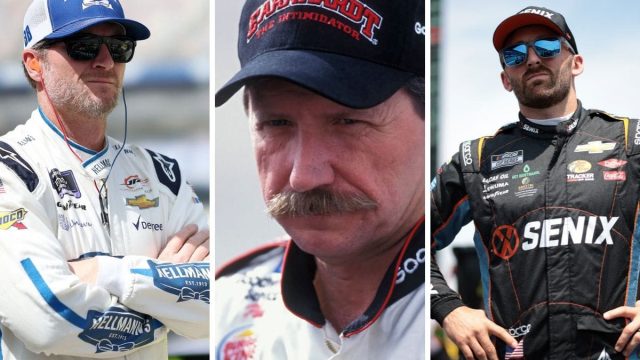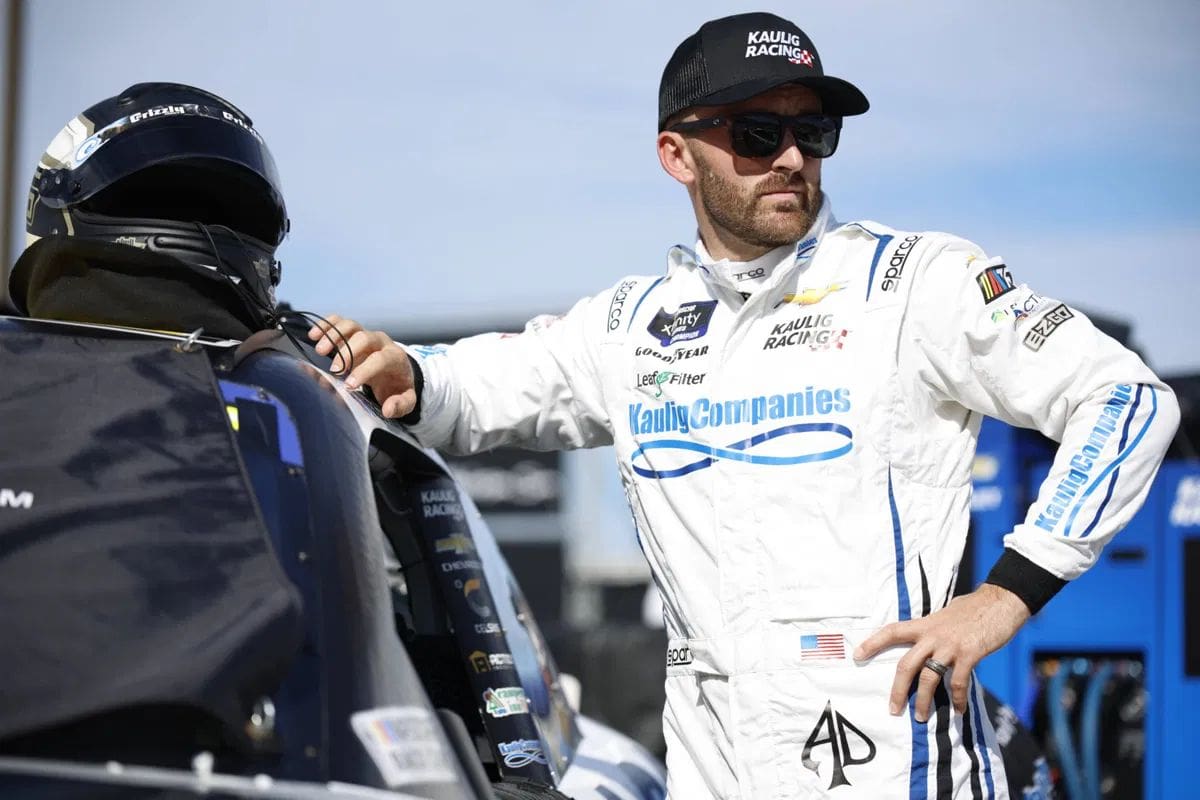Dale Jr. Defends His Father’s Legacy: The recent comparisons drawn between Austin Dillon and the late Dale Earnhardt Sr. have ignited a complex dialogue within the NASCAR community, prompting Dale Earnhardt Jr. to vehemently defend his father’s legacy. While acknowledging the aggressive driving style that defined his father’s era, Jr. emphasizes the profound shifts in racing dynamics that necessitate a reevaluation of such comparisons. This discourse reflects the evolving standards of the sport and raises questions about the implications for contemporary drivers and their legacies. As these conversations continue to unfold, the broader impact on the sport’s history remains to be seen.
Key Highlights
- Dale Earnhardt Jr. emphasizes the unique context of racing eras, contrasting the aggressive tactics of his father with those of Austin Dillon.
- He defends his father’s legacy, stressing the importance of understanding NASCAR’s evolving competitive dynamics over the years.
- Earnhardt Jr. highlights the distinct racing styles between drivers and the historical significance of the Earnhardt name in the sport.
- He acknowledges Dillon’s aggressive driving but insists that comparisons to his father should consider the differences in racing today.
- Dale Jr. is committed to preserving the integrity of the Earnhardt legacy while supporting Dillon’s pursuit of his own identity in racing.
Comparisons to Dale Earnhardt Sr. After Austin Dillon’s Win
The recent victory by Austin Dillon at Richmond Raceway has reignited discussions surrounding comparisons to the late Dale Earnhardt Sr., particularly due to Dillon’s association with the iconic No. 3 car. This monumental win not only marked Dillon’s initial of the season but also brought a wave of nostalgia, as fans and analysts similarly recalled Earnhardt’s formidable legacy.
The parallels drawn between the two drivers are complex, often stemming from the shared number and the substantial history it embodies within NASCAR. Dillon’s aggressive navigation, which particularly involved sending Joey Logano into the wall and spinning Denny Hamlin during the final lap, has been likened to Earnhardt’s own relentless style on the track.
Such comparisons, though, must be approached with caution. While both drivers exhibit a competitive spirit, the contexts of their racing careers differ markedly. Earnhardt’s 17-year reign in the No. 3 car produced unmatched achievements and a deep-seated connection with fans that transcends mere statistics.
The discussions around Dillon’s win highlight a broader tendency within motorsport to romanticize connections between past and present drivers. Particularly, figures like Jimmie Johnson and Kenny Wallace have drawn parallels, yet this can overshadow the unique attributes that define each racer.
Dale Earnhardt Jr. Defends His Father
Defending his father’s legacy, Dale Earnhardt Jr. has voiced strong opinions regarding the comparisons drawn between Austin Dillon’s recent win and the driving style of Dale Earnhardt Sr. While Dillon’s dramatic victory at Richmond Raceway included a last-lap altercation similar to the Intimidator’s aggressive tactics, Earnhardt Jr. emphasized the complexities of comparing different racing eras.
In a frank discussion on the Dale Jr. Download podcast, Earnhardt Jr. acknowledged his father’s reputation for rough driving, particularly during the late 1980s. However, he clarified that the context of those actions was distinct from modern racing dynamics. “I think that back then, certainly a different time, I don’t know if I ever saw dad ever clean two of them out in the last corner,” he remarked.
“You know, dad was rough. He had a little spell, especially in that blue and yellow car where 86 and 87, he got pretty rough.” – jr
This observation highlights a crucial nuance: while aggressive racing has always been part of NASCAR, the methods and consequences have evolved markedly.
Earnhardt Jr.’s defense highlights the importance of understanding the historical context of racing styles. Dale Earnhardt Sr. was known for his ability to navigate the complexities of competition with a mix of skill and intimidation, but his approach was often marked by a code of conduct that respected the integrity of the sport.
Reactions from Other Drivers
Numerous reactions from fellow drivers following Austin Dillon’s victory at Richmond Raceway emphasize the ongoing debate about the legacy of aggressive racing in NASCAR.
Jimmie Johnson, a seven-time Cup Series champion, took to social media to remark on Dillon’s performance, stating, “Dale Sr vibes,” a nod to the relentless pursuit of victory that characterized Dale Earnhardt Sr.’s career. This acknowledgment suggests that Dillon’s approach, marked by an unyielding desire to win, resonates with the qualities that made Earnhardt a legendary figure in the sport.
Dale Sr vibes https://t.co/VMpI26bcXD
— Jimmie Johnson (@JimmieJohnson) August 12, 2024
Kenny Wallace also weighed in, drawing parallels between Dillon’s aggressive tactics during the Federated Auto Parts 400 and Earnhardt’s infamous move against Terry Labonte at Bristol. While Wallace recognized the merit of Dillon’s resolve, he simultaneously critiqued the ethics of such actions, labeling them as “wrong.” This duality in Wallace’s response demonstrates the complexity of the conversation surrounding competitive spirit versus sportsmanship.
Richard Childress, Dillon’s grandfather and team owner, reinforced this perspective when he remarked on the similarities between Dillon and Earnhardt, stating, “Whatever it takes. I’m so proud of him.”
Childress’s endorsement highlights a generational continuity in NASCAR, where the pursuit of victory often supersedes conventional racing ethics.
These varied reactions from notable figures within the NASCAR community reflect a deeper discourse on the acceptable limits of competition, challenging the sport to reconcile aggressive strategies with the foundational principles of fair play.
Dillon’s Challenges and Legacy
Austin Dillon’s course in NASCAR has been marked by the weight of his family’s legacy, particularly the towering presence of his grandfather’s No. 3 Chevrolet and the indelible mark left by Dale Earnhardt Sr. Despite securing his fifth Cup Series victory at Richmond, Dillon continues to grapple with the relentless scrutiny of fans who expect him to embody the legacy of the legendary driver. This intense strain can overshadow his achievements and distort perceptions of his capabilities behind the wheel.
Dillon’s challenges extend beyond mere expectations; they include the constant comparisons that arise from his association with the Earnhardt name. While he has made efforts to distance himself from these parallels, particularly by emphasizing the strengths of his teammate, the specter of Earnhardt remains a formidable presence in his career narrative. Critics often question whether Dillon’s performance aligns with the historical skill of the No. 3 Chevrolet, leading to a complex dynamic where success feels heavily weighted against the backdrop of a revered legacy.
As Dillon stands at a crucial moment in his career, poised on the brink of potential playoff rivalry, the controversy surrounding his recent victory further complicates his expedition. With NASCAR’s upcoming verdict on the incident involving Joey Logano and Denny Hamlin, the uncertainty surrounding his race win adds yet another layer to the challenges he faces.
Dillon’s Response and Future Outlook
The burden of living up to a legendary surname often weighs heavily on athletes, and for Dillon, this reality is no different. In response to comparisons with Dale Earnhardt Sr., Austin Dillon clarified his stance, emphasizing his individuality and distinct racing style. He stated, “It never crossed my mind to tell you the truth. It happened that way.” His acknowledgment of Dale Sr.’s aggressive tactics highlights Dillon’s awareness of the legacy he is associated with, while simultaneously affirming his commitment to carving his own path.
“It never crossed my mind to tell you the truth. It happened that way. Yeah, I’ve seen a lot of races with Dale moving guys, pissing people off. A lot of people booed him throughout his career. I think Kyle Busch is the closest thing we’ve had to a Dale Earnhardt Sr. I’m not that. I’m Austin Dillon. I’m just going to try hard.” – Dillon
As the NASCAR season nears its playoff phase, Dillon’s focus shifts to securing his position within the postseason. With only three races left before the playoffs commence, he remains hopeful that his recent victory will be upheld, allowing him to retain his playoff spot. Meanwhile, Kyle Busch, another driver under Richard Childress Racing, seeks to emulate the competitive spirit of Dale Sr. at Michigan International Speedway, aiming to break his winless streak.
News in Brief: Dale Jr. Defends His Father’s Legacy
In view of the evolving landscape of NASCAR, Dale Earnhardt Jr.’s defense of his father’s legacy emphasizes the importance of contextualizing racing behaviors within their respective eras. The comparisons drawn between Austin Dillon and Dale Earnhardt Sr. highlight both the challenges and responsibilities faced by contemporary drivers. As the sport progresses, maintaining the integrity of the Earnhardt name remains paramount, necessitating a refined understanding of racing dynamics and the shifting codes of conduct that accompany them.
ALSO READ: Austin Dillon’s Richmond Win Reflects Dale Sr.’s Tactics, Says NASCAR Veteran



